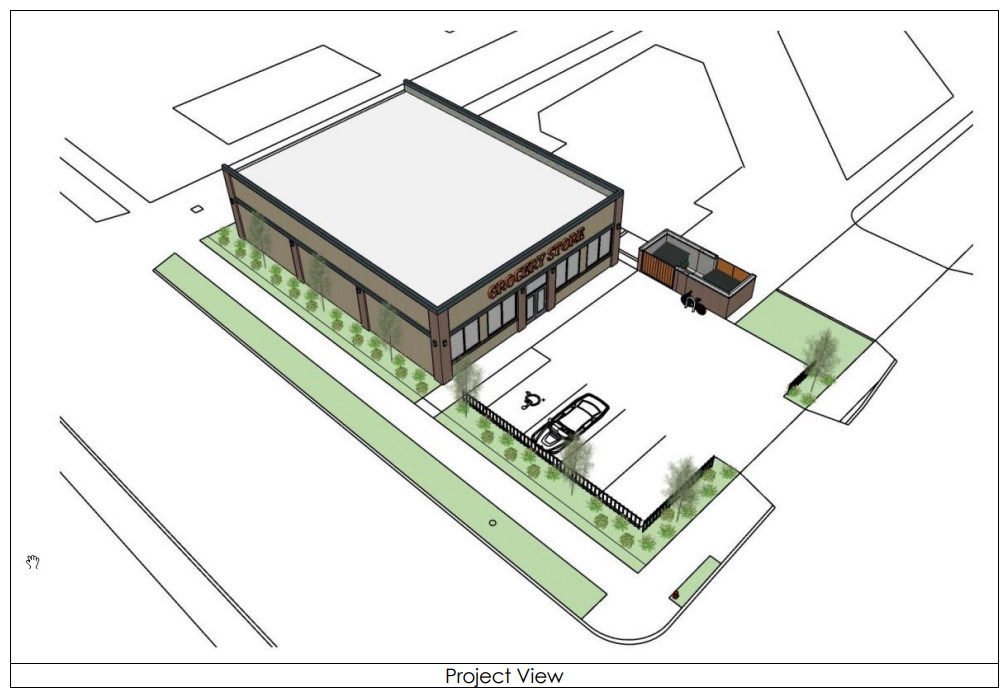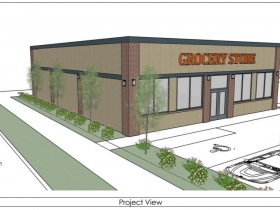Is This Good Urban Design?
Alderman objects to car-centric layout of proposed south side grocery store.
A Common Council committee approved a land sale related to constructing a new, small-format grocery store at 3530 W. Lincoln Ave., but not before one alderman objected to its car-centric design.
Mandeep Dhawan would buy the 6,600-square-foot lot from the city and construct a 3,136-square-foot building with a four-stall parking lot in front. Dhawan owns the adjacent gas station at 3510 W. Lincoln Ave. and others across the city.
“This seems contrary to our urban design principles,” said Alderman Robert Bauman at a Tuesday morning meeting of the Zoning, Neighborhoods & Development Committee.
“It’s an area that’s very much close to an industrial area,” said Department of City Development real estate analyst Yves LaPierre. He noted it’s just a couple blocks from the city’s south side drop off center.
The alderman suggested the parking lot should be in the rear. The parking in the rear layout is advocated by the Congress for New Urbanism and other urban design theorists as a way to create a better pedestrian environment and not favor automobiles.
“We don’t want the parking to be in the back because the back abuts an alley and a house,” said LaPierre.
Project architect Luis Barbosa Perches of BMR Design Group said he worked with DCD planners on the site layout. A five-foot green space buffer would be constructed on the west side of the corner lot along S. 36th St. “Some of the neighbors were extremely concerned about having the parking lot in the back,” said Barbosa Perches.
The Board of Zoning Appeals signed off on the plan, granting a variance for the parking lot.
Bauman objected to the design, voting against the land sale, but council members Jose G. Perez, Milele A. Coggs and Khalif Rainey voted for the deal sending it to the full council with a positive recommendation. Russell W. Stamper, II was absent from the meeting for a family matter.
The lot has been effectively vacant for decades, having only a billboard until recent years. The city acquired the property through property tax foreclosure in 2016.
Dhawan would pay $24,000 for the property and invest approximately $300,000 in developing the store.
Legislation Link - Urban Milwaukee members see direct links to legislation mentioned in this article. Join today
If you think stories like this are important, become a member of Urban Milwaukee and help support real, independent journalism. Plus you get some cool added benefits.
Related Legislation: File 191564
Political Contributions Tracker
Displaying political contributions between people mentioned in this story. Learn more.
- January 31, 2020 - Khalif Rainey received $250 from Mandeep Dhawan
- December 31, 2019 - Milele A. Coggs received $250 from Mandeep Dhawan
- January 7, 2017 - José G. Pérez received $300 from Mandeep Dhawan
- May 2, 2016 - Russell W. Stamper, II received $250 from Mandeep Dhawan
Eyes on Milwaukee
-
Church, Cupid Partner On Affordable Housing
 Dec 4th, 2023 by Jeramey Jannene
Dec 4th, 2023 by Jeramey Jannene
-
Downtown Building Sells For Nearly Twice Its Assessed Value
 Nov 12th, 2023 by Jeramey Jannene
Nov 12th, 2023 by Jeramey Jannene
-
Immigration Office Moving To 310W Building
 Oct 25th, 2023 by Jeramey Jannene
Oct 25th, 2023 by Jeramey Jannene


























Thanks, Alderman Baumann. Yes, You are right about pedestrian friendly design is the way we need to plan and build. The days of the automobile are soon to pass…or we will all pass.
I agree with Alderman Robert Bauman. I hope that the ideas of New Urbanism can be presented to help people see the benefits. One phrase the CNU is using is “It just works better” with the idea that urbanism need not intimidate people, but that better go to neighborhoods that build in goals of people-friendly design. Another issue is minimum parking requirements–sometimes a grocery store can’t be placed because, by law, it must have so much surface parking. Hence, you get small-format grocery stores, which could be a boon to a densely-populated walkable neighborhood, locate farther away. Eliminate the laws the require a minimum of parking, and this may ease the requirement for massive surface parking lots. Donald Shoup in the book Parking and the City (2018) covers this from a research and case study point of view.